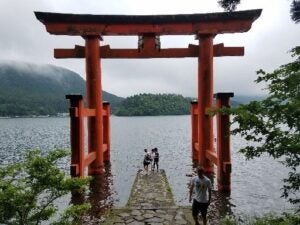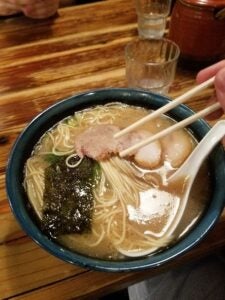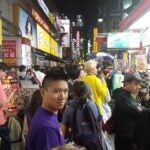Japan: An 'inexhaustible variety of life'
By Josh Butler, a junior EC Scholar
 Studying abroad in Tokyo, Japan, and the surrounding areas was an experience second to none that involved cultural immersion coupled with intellectual stimulation. Few places demonstrate values directly opposite to that of the United States like Japan, and experiencing these differences allows one to better understand the society he/she originates from and to view the United States from a foreigner’s perspective. Individualism versus collectivism; human rights versus rights of the collective whole; the person’s demand for respect versus a self-effacing respect for the other person; confrontation versus meekness; admittance versus ostracism. Juxtaposed standards such as these portray the differences between the United States and Japan respectively. Saying that experiencing these things profoundly increased my understanding of cross-cultural human nature would be a gross understatement.
Studying abroad in Tokyo, Japan, and the surrounding areas was an experience second to none that involved cultural immersion coupled with intellectual stimulation. Few places demonstrate values directly opposite to that of the United States like Japan, and experiencing these differences allows one to better understand the society he/she originates from and to view the United States from a foreigner’s perspective. Individualism versus collectivism; human rights versus rights of the collective whole; the person’s demand for respect versus a self-effacing respect for the other person; confrontation versus meekness; admittance versus ostracism. Juxtaposed standards such as these portray the differences between the United States and Japan respectively. Saying that experiencing these things profoundly increased my understanding of cross-cultural human nature would be a gross understatement.
 I went to Japan entirely open-minded; however, I continuously found myself surprised at each restaurant, turn of the block, or bend in the path. Describing each surprise would take far too long for the purpose of a blog and simply not do the experience justice, so I will attempt a few. To begin with, convenience stores brought a whole new meaning to the word convenience. Instead of merely carrying an assortment of snacks, drinks, and simple essentials for the road, the common 711 or Family Mart convenience store in Japan was also full to the brim with fresh meals ranging from sandwiches to meats and bread. I often found myself in one of these stores to stock up on food for the guest house, grabbing a quick meal before our next excursion, or withdrawing cash from its ATM.
I went to Japan entirely open-minded; however, I continuously found myself surprised at each restaurant, turn of the block, or bend in the path. Describing each surprise would take far too long for the purpose of a blog and simply not do the experience justice, so I will attempt a few. To begin with, convenience stores brought a whole new meaning to the word convenience. Instead of merely carrying an assortment of snacks, drinks, and simple essentials for the road, the common 711 or Family Mart convenience store in Japan was also full to the brim with fresh meals ranging from sandwiches to meats and bread. I often found myself in one of these stores to stock up on food for the guest house, grabbing a quick meal before our next excursion, or withdrawing cash from its ATM.
 Many people tend to look at a picture of Tokyo and liken it to New York City. Even though the skyscrapers are similar, the size of Tokyo, the biggest city in population density in the world that sports more places to eat than any other city, is simply too large to compare to its New York counterpart. Tokyo is also much cleaner, partly due to the lack of trash cans, subsequent reduction of trash quantity, and the taboo of eating while walking throughout the city. Trash is also separated between burnable items and plastics, reducing the necessity of landfills, unlike US practices.
Many people tend to look at a picture of Tokyo and liken it to New York City. Even though the skyscrapers are similar, the size of Tokyo, the biggest city in population density in the world that sports more places to eat than any other city, is simply too large to compare to its New York counterpart. Tokyo is also much cleaner, partly due to the lack of trash cans, subsequent reduction of trash quantity, and the taboo of eating while walking throughout the city. Trash is also separated between burnable items and plastics, reducing the necessity of landfills, unlike US practices.
Some restaurants feature a vending machine-like way of ordering. On the machine are pictures of meals (which are not photo shopped, like almost every menu in the US) and prices. After inserting some coins or a paper bill and choosing a meal, a ticket spi ts out, and the customer then passes it on to the cook. Pitchers of water are typically left on the table so you can refill the small glass as needed. Also, a waiter or waitress will only stop by your table if and when you call for their attention. From what I could discern, this is because meals are considered a private affair that are not to be interrupted unless the waiter/waitress is needed by the customer. I often forgot about this and waited at the table with friends, waiting for the waiter, when in fact the waiter was waiting for us.
ts out, and the customer then passes it on to the cook. Pitchers of water are typically left on the table so you can refill the small glass as needed. Also, a waiter or waitress will only stop by your table if and when you call for their attention. From what I could discern, this is because meals are considered a private affair that are not to be interrupted unless the waiter/waitress is needed by the customer. I often forgot about this and waited at the table with friends, waiting for the waiter, when in fact the waiter was waiting for us.
Food portions are generally much smaller than in the US, and a typical meal consists mostly of noodles or rice, vegetables, and a small portion of meat (usually fish or pork). In addition, there are numerous American fast food restaurants, such as Carl Jr.’s, McDonalds, and KFC, in Japan. These restaurants demonstrate how Japan has been gradually westernized, influencing not only eating habits but choice of clothing and music as well.
Japan is a mesmerizing conjunction of the traditional and contemporary, the old and the new, the natural beauty of mountains and its wild monkeys and the adjacent concrete jungle of skyscrapers and modern wonders. These first-hand experiences have allowed me to see the United States from a fresh perspective and better comprehend what F. Scott Fitzgerald described as the “inexhaustible variety of life.”



